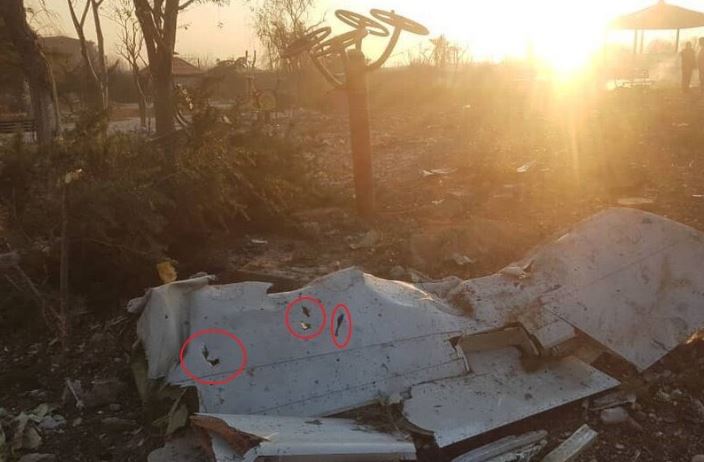In the wake of the crash of Ukrainian International Airlines Flight 752 in Tehran this morning, two schools of thought quickly emerged. The first accepted the explanation given by Iranian authorities: that the 3-year-old 737-800, which had taken off minutes before, had suffered engine failure before plunging into the ground at Khalaj Abad, killing all 176 aboard. The second, widespread on the internet, was that the Kiev-bound plane had been accidentally shot down by an Iranian air-defense missile.
Given that the facts are just starting to trickle in, it’s far too early to say with any certainty what actually happened. Based on past experience, much of what has been reported as fact will turn out to be wrong; the true cause may very well turn out to be something no one has yet considered. But given the information we have right now, the second explanation makes more sense than the first.
According to flight data recorded by Flightradar 24, the plane took off at 2:42 universal time, or 6.12 a.m. local time, a little more than three hours after Iran launched more than a dozen ballistic missiles at Iraqi bases hosting U.S. troops. Three minutes later, it had reached an altitude of nearly 8,000 feet and was continuing to climb at a steady ground speed of 276 knots, or 318 mph. Then, abruptly, it dropped. A state-run Iranian media outlet released a video that appeared to show the aircraft descending in flames before impacting the ground.
An Iranian official told the IRNA news agency that a fire had broken out in one of the engines, causing the pilot to lose control.
We are following reports that a Ukrainian 737-800 has crashed shortly after takeoff from Tehran. #PS752 departed Tehran at 02:42UTC. Last ADS-B data received at 02:44UTC. https://t.co/qXWHUPGDTu pic.twitter.com/vuAi6TOqTp
— Flightradar24 (@flightradar24) January 8, 2020
Engine malfunctions can certainly cause planes to crash but generally not in the manner observed with Flight 752. The wing, not the engine, is what keeps a plane in the air, and even if a plane loses power in all its engines, it can still glide for a considerable distance under pilot control (see: the Miracle on the Hudson). Even if an engine catches fire, the flight crew generally has time to respond.
Worth noting too is that Iran’s explanation came implausibly quickly, before officials had scarcely had a chance to pick through the still-smoldering debris. Tellingly, Ukrainian officials, who had endorsed the engine-failure explanation soon after the crash, soon backtracked, saying it was too early to ascribe a cause.
Meanwhile, the sudden loss of flight data suggests a catastrophic event that instantly destroyed or disrupted the electronic equipment that transmits the data.
To be sure, there are ways other than a missile strike that a passenger plane can come to catastrophic grief soon after takeoff. In the case of Flight 752, however, none seem to fit very well. The plane was fairly new, the pilots quite experienced. It is plausible, however, that Iranian air-defense forces would have been on high alert. President Trump had already warned that the U.S. military would aggressively bomb Iran if the country used force in the spiraling escalation between the two countries. Tehran, the nation’s capital, would be an obvious target. Memories remain fresh of U.S. airstrikes against Baghdad at the start of its wars against Iraq.
If the tragedy was indeed the result of an accidental shoot-down, it presents eerie echoes of the destruction of Iran Air 655, an Airbus A300 that the U.S. destroyer Vincennes shot down on July 3, 1988, killing all 290 aboard. That accident also happened during a period of heightened tensions between the U.S. and Iran — though in that case, it was overeager U.S. personnel who mistakenly pulled the trigger.
In the wake of this morning’s crash, some voices argued against premature speculation. For instance, one much-circulated set of images showed the plane’s wreckage with circles around what seemed to be puncture marks from shrapnel. Nick Waters, a member of the group Bellingcat, which did extensive open-source intelligence investigations into another shoot-down of a civilian airliner (MH17 over eastern Ukraine in 2014), urged caution. “Hey all, be careful about analysis of holes in various parts of the plane,” Waters tweeted. “For example: these images show the same piece, where at least some of the ‘holes’ actually appear to be small rocks or other debris in higher resolution images.”
Given the pace of air-crash investigations, it will be at least several days before a clearer picture emerges and months or years before the truth can definitively be known. For now, the tragedy seems almost uncannily engineered to stimulate public reaction with a trifecta of breaking-news hashtags: Boeing, Iran, and Ukraine.











